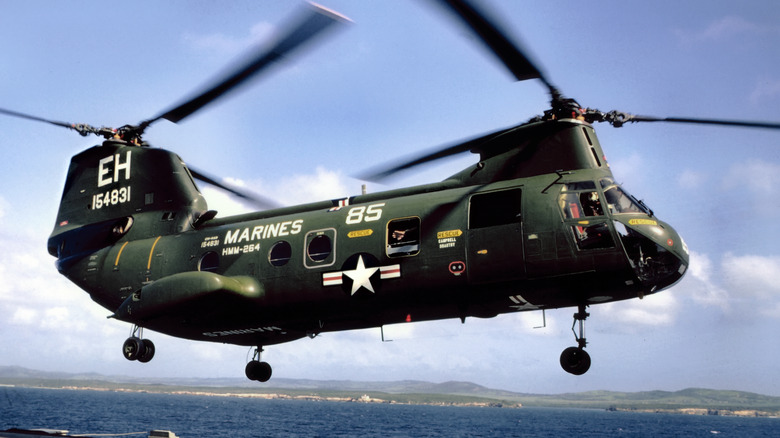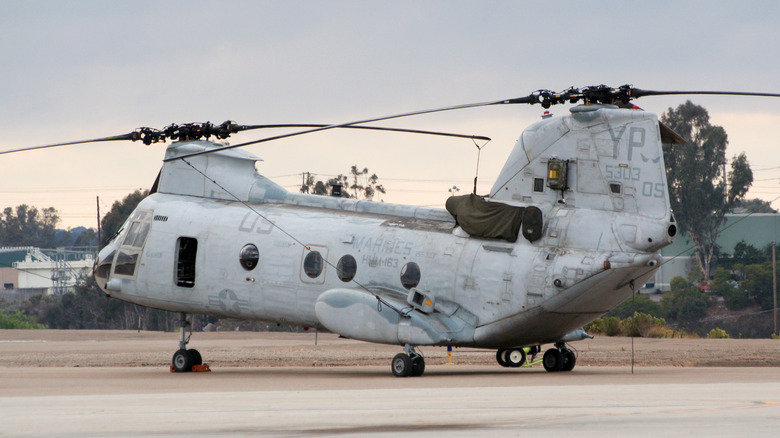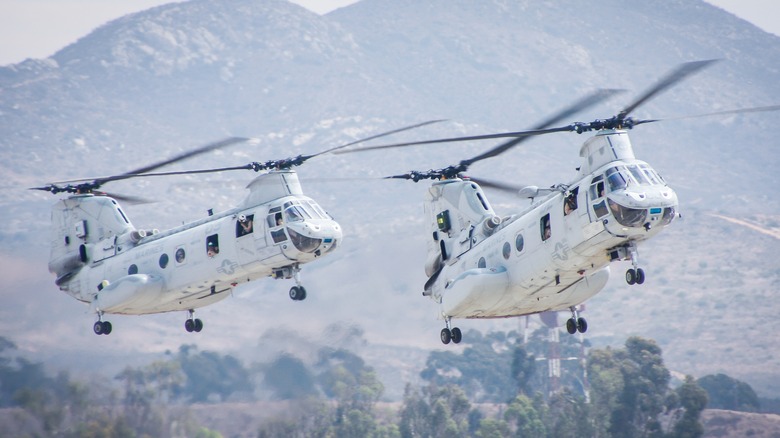How This Vietnam-Era Helicopter Became Indispensable
In the late 1950s, the U.S. military was in need of new troop and cargo assault helicopters to replace a motley crew of aging piston-engined aircraft. In order to have a favorable position in the competition for the contract to build the new helicopters, Boeing acquired the Vertol Corporation in 1960. Vertol, short for "vertical takeoff and landing," was considered a pioneer in tandem rotor helicopters and had three different designs under development at the time of Boeing's takeover, one of which was the twin-turbine CH-46A Sea Knight that would go on to win the bid for the Marine Corps in 1961.
The helicopter was built to transport 17 fully-equipped troops or tote 4,000 pounds of cargo at a cruising speed of 150 miles per hour per requirements from the Marine Corps. To accomplish this, the Sea Knight's design included a pair of 1,250 horsepower turbine engines installed in a pylon above the rear fuselage, with a long driveshaft extending forward to power the front rotor. This was done to keep mechanical gear from occupying valuable space in the cabin and to allow vehicles and troops to be loaded via a large rear ramp, which could also be left open during flight for dropping cargo by parachute.
The Sea Knight's first test flights were made in August 1962 and the first production units were delivered in 1964, just in time for the rapidly escalating war in Vietnam.
It was a staple in Vietnam
After being pressed into service, the CH-46A didn't pack enough punch for Vietnam combat. So by 1966, the Sea Knight's performance was enhanced with the introduction of the CH-46D, which had more powerful 1,400 horsepower engines and a modified rotor design that facilitated carrying up to 25 troops or 7,000 pounds of cargo. Yet another iteration, the CH-46F, emerged in 1968 with an improved navigation system and better all-weather flying characteristics.
The Marines Corps flew the helicopters throughout the duration of the Vietnam War, shuttling troops and equipment to the front lines and evacuating the wounded. At some point during the conflict, the Marines abandoned the formal Sea Knight monicker and began calling them "Phrogs," undoubtedly due to the craft's frog-like appearance when viewed from the front. Unfortunately, the increased capacity that made them such an asset as a utility-transport helicopter also created the liability of being an easy target. In total, over 100 phrogs were shot down.
The CH-46's final role in Vietnam was the rescue of nearly 8,000 people from the U.S. Embassy during the fall of Saigon in 1975. It was dubbed "Operation Frequent Wind."
The Sea Knight's career spanned six decades
In a 2012 interview with The Marine Corps Times, Col. David Walsh, manager of the CH-46 program at Naval Air Systems Command stated, "The CH-46 has really been the backbone of the Marine Corps medium-lift, assault-support fleet ... They have participated in every engagement the Marine Corps has since they were introduced back in Vietnam."
The final Marine Corps flight of the CH-46 took place in October 2014. It's since been replaced by the faster, more agile MV-22 Osprey, which is capable of horizontal flight and reaching speeds previously only achieved by airplanes. Some of the retired Phrogs have found their way to aviation and military museums, others have been transferred over to the State Department for diplomatic missions, and some were stored for spare parts.
In 2021, a State Department CH-46E Sea Knight was photographed rescuing people from the roof of the U.S. Embassy in Kabul during America's withdrawal from Afghanistan, the same role it had served in Saigon nearly five decades prior.


